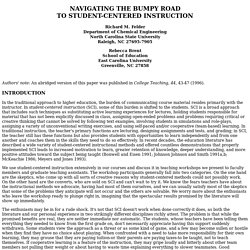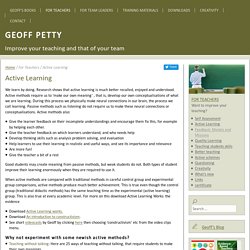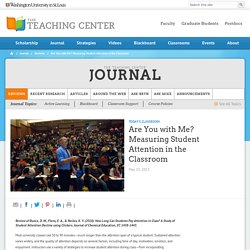

Infusing Active Learning into the Large-enrollment Biology Class: Seven Strategies, from the Simple to Complex. + Affiliations The greatest single challenge to SMET pedagogical reform remains the problem of whether and how large classes can be infused with more active and interactive learning methods.

Elaine Seymour (2001) Science educators are urged (National Research Council [NRC], 1997, 2003; National Science Foundation, 1996) to adopt active-learning strategies and other alternatives to uninterrupted lecture to model the methods and mindsets at the heart of scientific inquiry, and to provide opportunities for students to connect abstract ideas to their real-world applications and acquire useful skills, and in doing so gain knowledge that persists beyond the course experience in which it was acquired. While these and other calls for reform dangle the carrot of promised cognitive gains before us (Bransford et al., 1999), the process of translating their message into the realities of practice in given classroom contexts remains a challenge of considerable magnitude.
Resistance Paper. Richard M.

Felder Department of Chemical Engineering North Carolina State University Raleigh, NC 27695-7905 Rebecca Brent School of Education East Carolina University Greenville, NC 27858 Authors' note: An abridged version of this paper was published in College Teaching, 44, 43-47 (1996). In the traditional approach to higher education, the burden of communicating course material resides primarily with the instructor. In student-centered instruction (SCI), some of this burden is shifted to the students. We use student-centered instruction extensively in our courses and discuss it in teaching workshops we present to faculty members and graduate teaching assistants. The enthusiasts may be in for a rude shock.
101_Tips.pdf. Active Learning - Geoff PettyGeoff Petty. We learn by doing.

Research shows that active learning is much better recalled, enjoyed and understood. Active methods require us to ‘make our own meaning’ , that is, develop our own conceptualisations of what we are learning. During this process we physically make neural connections in our brain, the process we call learning. Passive methods such as listening do not require us to make these neural connections or conceptualisations. Active methods also: Give the learner feedback on their incomplete understandings and encourage them fix this, for example by helping each other.Give the teacher feedback on which learners understand, and who needs helpDevelop thinking skills such as analysis problem solving, and evaluationHelp learners to use their learning in realistic and useful ways, and see its importance and relevanceAre more fun! Good students may create meaning from passive methods, but weak students do not. Why not experiment with some newish active methods?
Active Learning. Research suggests that audience attention in lectures starts to wane every 10-20 minutes.

Incorporating active learning techniques once or twice during a 50-minute class (twice to or thrice for a 75-minute class) will encourage student engagement. Active learning also: Implementing any new teaching technique can be a daunting or challenging task. Some students may not accept new learning activities with complete ease. Rather than trying to engage all students, focus on engaging more students in more meaningful ways. Angelo, T.A. & Cross, K.P. (1993). Bonwell, C. Davis, B.G. (2009). Deslauriers L, Schelew E, Wieman C. (2011). Are You with Me? Measuring Student Attention in the Classroom. Most university classes last 50 to 90 minutes—much longer than the attention span of a typical student.

How long can you reasonably expect your students to sustain attention in the classroom? Review of Bunce, D. M., Flens, E. A., & Neiles, K. Y. (2010). Most university classes last 50 to 90 minutes—much longer than the attention span of a typical student. How long can you reasonably expect your students to sustain attention in the classroom? In another study of student attention in the classroom, trained observers watched students during a lecture class and recorded perceived breaks in attention (Johnstone & Percival, 1976). More recently, Bunce et al. (2010) revisited the measurement of student attention during class by asking students in three introductory chemistry courses to report lapses in attention using “clickers” (small devices on which students can remotely register button-press responses to questions or prompts).
Attention Lapses are Frequent, but Brief Study Limitations.